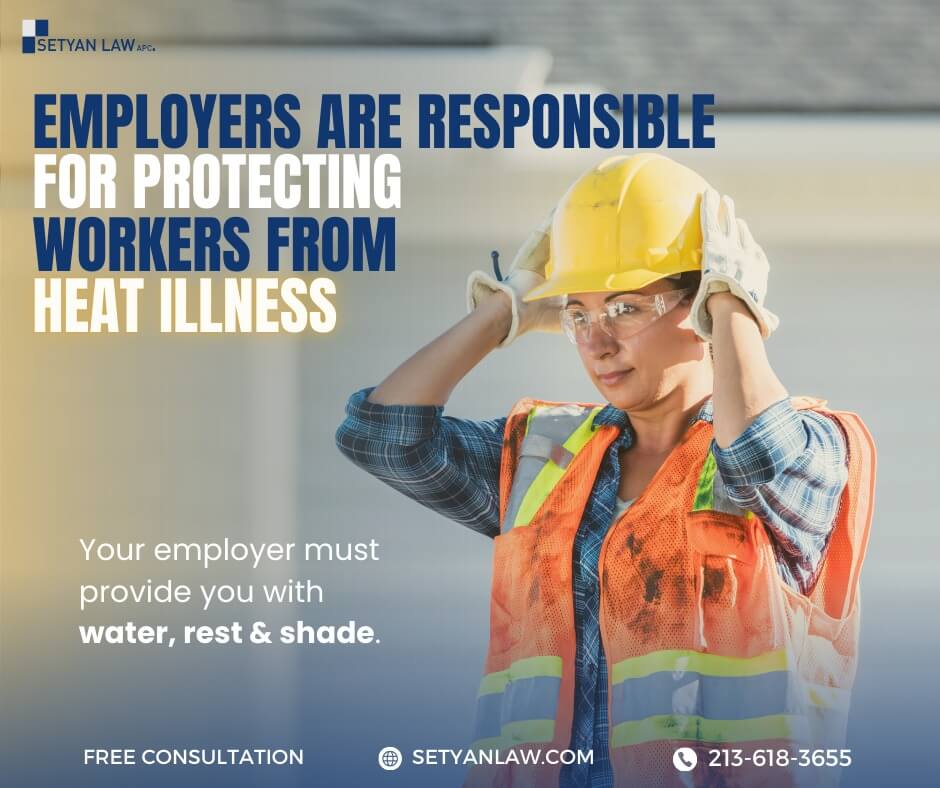Updated August 9, 2024
California Code of Regulations, Title 8, Section 3396
As the mercury rises and temperatures soar, California has taken a bold step to safeguard the well-being of its indoor workforce. The state’s recently implemented heat illness prevention regulation aims to shield employees from the dangers of extreme heat, marking a significant milestone in workplace safety. This groundbreaking policy, the first of its kind in the nation, has set the stage for a new era of worker protection, empowering individuals to thrive in their workplaces regardless of the thermometer’s reading.
Scope and Applicability of the Indoor Heat Illness Prevention Law
The newly enacted California law targets indoor workplaces where temperatures reach or exceed 82 degrees Fahrenheit. This regulation applies to a wide range of industries, including restaurants, warehouses, manufacturing facilities, and other indoor environments. By establishing clear guidelines and mandates, the state has sought to create a safer and more comfortable working atmosphere for employees across a diverse array of sectors.
Exceptions and Exclusions
While the law’s reach is extensive, it does make some exceptions. Notably, local and state correctional facilities, jails, and prisons are currently exempt from the regulation. Cal/OSHA, the state’s occupational safety and health agency, has acknowledged this gap and is actively developing an industry-specific standard to address the unique challenges faced by these workplaces. Additionally, emergency operations directly involved in the protection of life or property are also exempt from the new requirements.
Key Provisions of the Indoor Heat Illness Prevention Law
The California law outlines a comprehensive set of measures employers must implement to safeguard their indoor workforce from the dangers of heat exposure. These provisions include:
Provision of Clean, Accessible Water
Employers are required to provide their employees with fresh, potable water that is readily available and free of charge. When there is no access to running water, employers must ensure that each worker is provided with at least one quart of drinking water per hour.
Establishment of Cool-Down Areas
Employers must designate and maintain cool-down areas within the workplace, where the temperature is kept below 82 degrees Fahrenheit. These areas must be easily accessible and large enough to accommodate the number of workers on rest breaks, allowing them to sit comfortably without touching one another.
Mandatory Rest Breaks
The law mandates that employers allow and encourage their workers to take preventative cool-down rest periods when they feel the need to do so. During these breaks, employers must monitor the employees, ensure they remain in the cool-down area, and refrain from ordering them back to work until any signs or symptoms of heat illness have been resolved.
Monitoring and Intervention
When the indoor temperature reaches 87 degrees Fahrenheit or when workers are exposed to high-radiant heat sources, employers must implement additional control measures. These may include more frequent breaks, adjustments to work schedules, slowing the pace of work, or providing cooling devices to maintain a safe working environment.
Training and Emergency Response
Employers are required to provide comprehensive training to their workers and supervisors on recognizing and responding to heat-related illnesses. Additionally, they must have in place effective emergency response procedures to provide first aid or seek medical attention for any employees exhibiting signs of heat-related distress.
Comparison to Outdoor Heat Illness Prevention Regulations
California’s indoor heat illness prevention law builds upon the state’s existing outdoor heat illness prevention standard, which has been in place since 2006. While the two regulations share some similarities, such as the requirement to provide water, shade, and rest breaks, there are notable differences:
Scope and Trigger Temperatures
The outdoor heat illness prevention standard applies when outdoor temperatures exceed 80 degrees Fahrenheit, while the indoor regulation takes effect when indoor temperatures reach or surpass 82 degrees Fahrenheit.
Cool-Down Areas vs. Shade
The outdoor standard mandates the provision of shade, while the indoor law requires the establishment of cool-down areas with temperatures below 82 degrees Fahrenheit.
High-Heat Procedures
The outdoor standard includes specific “high-heat procedures” that must be implemented when temperatures reach 95 degrees Fahrenheit or higher. The indoor law does not have a similar high-heat provision, but rather requires additional control measures when the temperature reaches 87 degrees Fahrenheit.
Compliance and Enforcement
To ensure the effectiveness of the indoor heat illness prevention law, Cal/OSHA has taken several steps to support employers in their compliance efforts. The agency has made available a range of educational materials, including fact sheets, fillable written safety plans, and frequently asked questions, to help businesses understand and implement the new requirements.
Worker Complaints and Enforcement Actions
Workers who believe their workplaces are not adequately protecting them from extreme heat conditions can file a complaint with Cal/OSHA, either online or by calling the dedicated hotline. The agency has pledged to investigate these complaints and take appropriate enforcement actions against non-compliant employers.
Penalties for Violations
Employers found to be in violation of the indoor heat illness prevention law may face significant penalties, including monetary fines and potential legal consequences. The severity of the penalties will depend on the nature and extent of the violations, as well as any previous infractions.
Implications and Impacts
The implementation of California’s indoor heat illness prevention law marks a pivotal moment in the state’s ongoing efforts to safeguard the well-being of its workforce. This groundbreaking regulation has the potential to serve as a model for other states and the federal government, inspiring the adoption of similar measures across the nation.
Benefits for Workers
By mandating the provision of clean water, cool-down areas, and mandatory rest breaks, the law directly addresses the critical needs of workers in hot indoor environments. This not only protects them from the immediate dangers of heat-related illnesses but also promotes overall workplace health and productivity.
Challenges for Employers
While the law’s implementation aims to enhance worker safety, it also presents challenges for employers, particularly in industries with inherently hot working conditions, such as restaurants and manufacturing facilities. Ensuring compliance with the new requirements within a relatively short timeframe may strain resources, especially for small businesses.
Potential for Expansion and Refinement
As the law takes effect and its impacts are evaluated, there may be opportunities for further refinement and expansion. Advocates have already expressed concerns about the temperature thresholds, suggesting that they may not adequately protect workers engaged in physically demanding tasks or those working in high-humidity environments.
Conclusion
California’s landmark indoor heat illness prevention law stands as a testament to the state’s commitment to safeguarding the well-being of its workforce. By establishing clear guidelines and mandates, this groundbreaking regulation has the potential to transform workplace safety, setting a new standard for the nation. As employers navigate the challenges of compliance, and workers reap the benefits of enhanced protection, this law represents a significant step forward in the ongoing quest to create safer, healthier, and more resilient workplaces.
Is your employer breaking the law? Call Setyan Law at (213)-618-3655 for a consultation.






